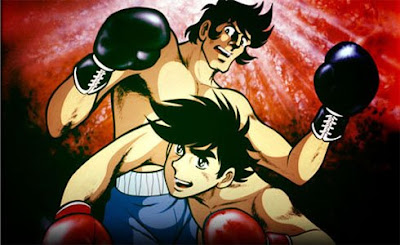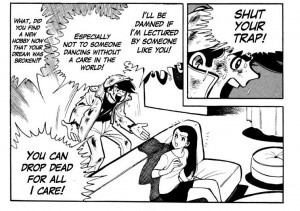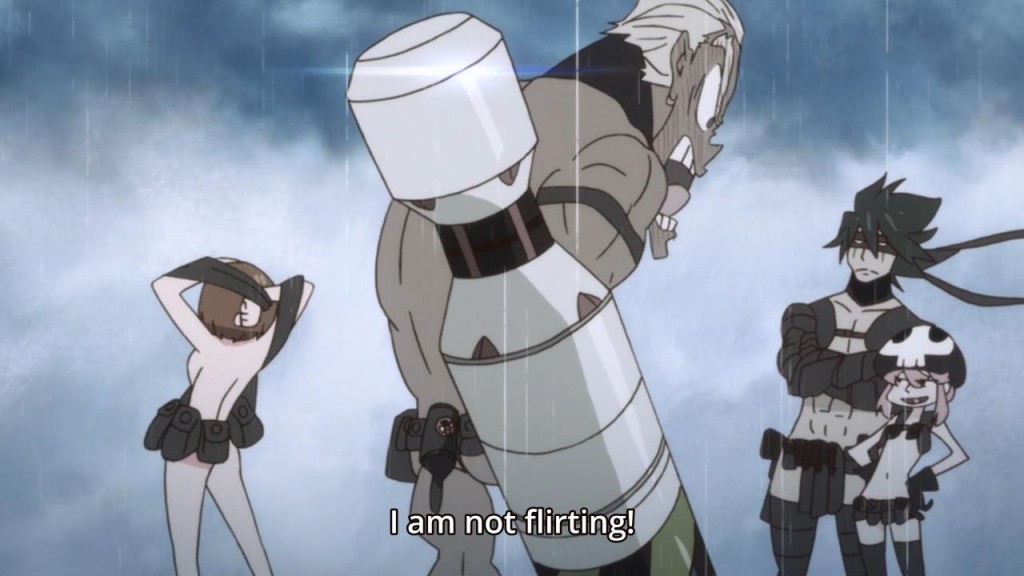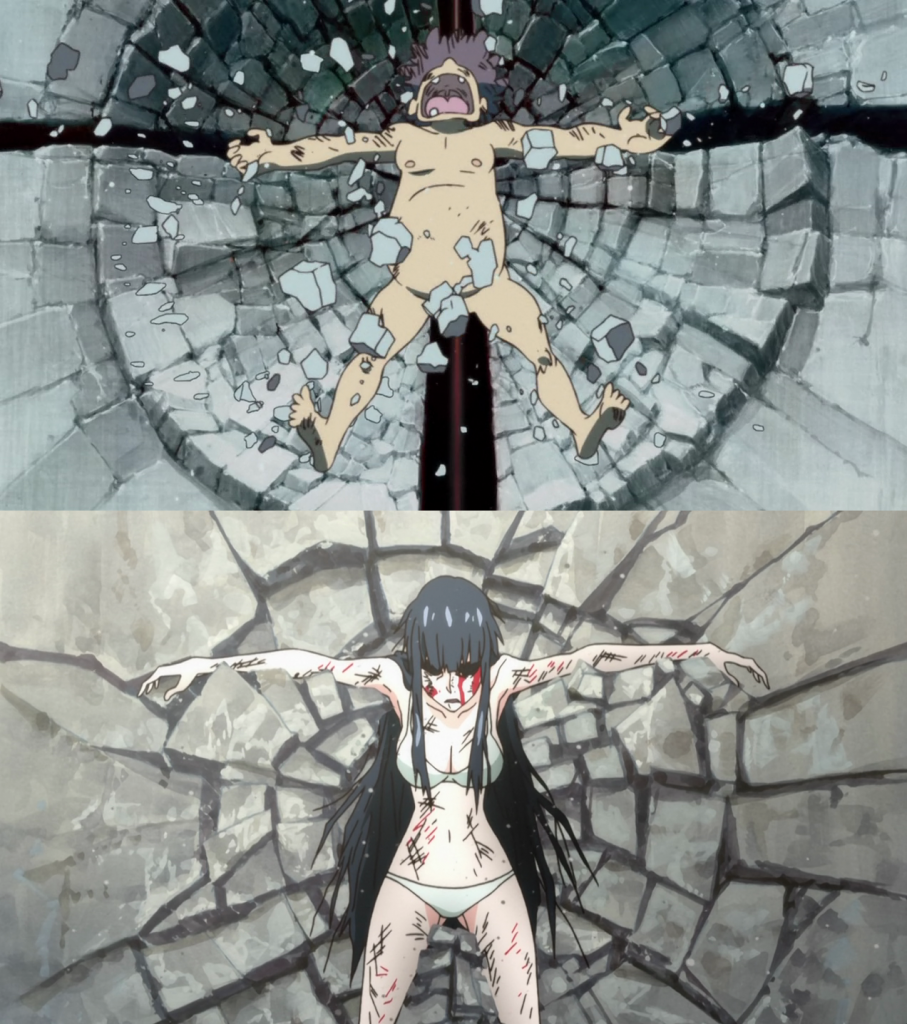
In 1968, writer Ikki Kajiwara (or whatever his real name is) and artist Chiba Tetsuya teamed up to create one of the most influential and critically-acclaimed manga of all time. It was a gritty, and at times surprisingly dark, manga about a young man from the slums who slowly rises to fame in Japan as he pursues a career in boxing. The story itself sounds basic enough from that description, which unfortunately does it absolutely no justice since what you actually read on paper is far more captivating and endearing than anything that I can transcribe with my limited writing talent (or complete lack, thereof) would fail to properly convey just how truly great this series is. Yet, I’m shameless and have nothing better to do at the moment (or I do, but am choosing to neglect it for some reason), so I will persist with this endeavor, anyways.
Ashita no Joe roughly translates to “Joe of Tomorrow” or “Tomorrow’s Joe,” with either title being either meaningful or ultimately irrelevant depending on what you get out of the series. The way I interpret it, the “tomorrow” of the title has more to do with how the series is a metaphor for the lower-class of Japan at that time (many of who would read manga of this sort for the sake of escapism….only to be bitten by the harsh reality of how close to home this manga would hit for them), and how Joe represented these people as the model post-World War II Japanese lower-class delinquent citizen. Yet his struggles and rise to fame throughout the series are representative of how Joe is the hope for the people of the slums, and consequently is meant to be a symbol of hope for the readers as well, though that’s touching into things that I have absolutely no expertise in, so it’s just theory on my part, but it would certainly help to explain why this manga was as big of a phenomenon as it was at the time. Of course, there is one other reason that it was such a big hit and still continues to be insanely popular to this day (in Japan, anyways; it’s ridiculously obscure almost anywhere else): It’s just really, REALLY fucking good. That certainly helps its memorability out as well, I would assume. However, that just begs the question: What exactly is so good about it?

And I mean besides half-naked men beating the shit out of each other. That goes without saying.
Well, in the interest of keeping things spoiler-free to attract some potential new (and much needed) fans, I should probably just get to a general synopsis of this manga’s basic set-up. You see, what works as both a huge strength yet potential detriment to this manga is the beginning act. What I mean is that, it’s something that those who respect a very well-constructed story over just getting to the action would appreciate, but unfortunately that description doesn’t encompass quite that many people who are known for reading shounen manga, let alone sports titles. Indeed, you may be very surprised to find that, despite being manga known for boxing, there isn’t a single boxing match to be found until well into the 4th volume. What precedes this is a little something that I like to call “character building” (as in: something that more manga should probably do more often). You see, Ashita no Joe doesn’t feature characters who are a vehicle for a sport that it’s trying to promote. It features characters, and just happens to have a lot to do with this sport, but it’s not really ABOUT this sport, but rather it’s ABOUT these characters, first and foremost.
So then, when the story does start, and we are introduced to our star Joe Yabuki, we don’t find out that he’s some seemingly nasty ass-hole jerk with a heart of gold who’s destined for great things. We instead find out that he’s JUST a nasty ass-hole jerk….and even that might be a bit too nice of a description. He wanders around the slums of some obscure and unknown town, getting into fights with Yakuza, and beating up some towns-folk in the mix as well (namely little kids, but to be fair those fuckers are pretty vicious for little pip-squeaks):

And child abuse isn't the only touchy subject that this manga toyed around with....it was a very different time....
It’s through one of these fights (the one where he fights against opponents that wouldn’t get this manga pulled for promoting child-abuse) that Joe’s incredible fighting-prowess and great potential as a boxer is discovered by a washed-up homeless old man, Danpei Tange, who was none other than an ex-boxer himself.
Throughout much of the beginning of the series, Danpei tries his best to convince Joe to train under him. At first Joe is uninterested, until he sees that he can use the old guy for some shelter and a little bit of money on the side. So, he pretends to go along with Danpei and trains under him, but constantly uses what little money he gets from him to go gambling and perform other shenanigans behind his back. Eventually he starts getting into more risky schemes, like stealing items from stores and selling them to townsfolk as an unlicensed street vendor for incredibly cheap prices. This naturally attracts the attention of the police, and once Danpei catches wind of this, he shows off some of his boxing skills to Joe first-hand, knocking him out and turning him into the police for his own good.
After spending some time at a Tokyo correctional-house (and acting like a complete wise-ass in front of a psychiatric evaluator), Joe is sent to court where he pretty much provokes the Judge into sending him to jail. It’s at this point you get an idea of just how mentally troubled this guy is, to an extreme that no other shounen manga would intentionally be willing to go to. Yet at the same time, it makes him so much more fascinating since, while you’re probably used to seeing the continual progression of the main character in a series of this nature, Joe first has to come head-to-head with his self-destructive behavior, and essentially must sink to his lowest point before he can truly be open to any change. There was another series from recent memory that tried something like that, but I remember it kind of sucking at following through with that point. Needless to say, this series is a MUCH better example of how to do that the right way.

Don't be too upset, Korra, most shows look like shit compared directly to this series. At least you're still better than Thundercats (2011).
After this point, Joe Yabuki is sent off to jail, and then….this manga actually begins. Yes, it is in fact best to think of everything that happened up to this point as a prologue. The most famous aspects of this this manga, and the reasons for why it’s so highly regarded, start from here on out. At first, the other inmates at the juvenile prison beat the crap out of Joe and the other guy sent in with him, Nishi. Despite being a big guy, Nishi is a bit of a pussy at the start of the series, and thus clings behind Joe who is much tougher and really ends up dominating the other inmates in almost no time at all. Hell-bent on a ridiculous escape-plan of his, he attempts to leave when he has the opportunity and then gets thwarted by another inmate, Rikiishi Tooru, who not only prevents his escape but also knocks him out in one punch. It’s shortly after this that Joe finds out that Rikiishi was an ex-boxer who was ranked 6th in Japan in his weight class, and was sentenced to some time in prison after getting into numerous street-fights. Now, all of a sudden, Joe has someone who is far stronger than him, and has a goal to work towards. It is then that he starts accepting visits from Danpei (who had been trying his hardest to get to see Joe in prison, as to the old guy’s credit, he was still hell-bent on teaching him how to be a boxer).
From this point on the manga becomes a non-stop read, and would surprise anyone with some of the most emotional and heart-wrenching story developments and character moments that have ever graced the finest works of fiction out there. What really wins me over, though, is the character development. It is by far some of the most convincing that I have ever seen in any manga or comic book, and it features something that you rarely see in these types of a series: a fluctuation. That is to say, if this manga is indeed about the life of Joe Yabuki, we see both the highs and lows that he comes to, and no, going to prison is not the only low he ever sinks to in this series. Indeed, for as many times as he rises up, we also see him sink to new depths, and at one point this manga portrays one of the most well-written depictions of depression in a fictional series that I have ever seen (coming from someone who has known many family members who have undergone major depression). That isn’t to say that it’s realistic, but rather that it is very good symbolism for what some can go through during that period of their life if they truly succumb to it.

Being allowed access to an elusive night-club to get drunk off your ass when you're clearly underage not withstanding.
What truly captivates me about the character of Joe Yabuki, however, more than anything else, is just how damn human he feels. Despite how much he develops throughout the series, he is always far from perfect, and in fact is a man who very much creates many of his own problems, either through his irrational and hot-headed behavior, or through his iron-willed determination which is not always depicted as a good thing as it is in most other shounen series. At the same time, he is a surprisingly likable character by the second half of the story, as readers would really gain an understanding of just how the character thinks by that point in time, and it’s almost as if one could grow an appreciation of his attitude by then in the way that Kajiwara effectively writes for the character.
One such trait that I myself have come to respect in particular is just how cynical Joe is. It’s not necessarily a good thing, but like many things about Joe’s characters, his flaws can actually make him more appealing. You see, Joe is someone who has been a loner for most of his life, and thus doesn’t trust people. In one scene, he has an outburst toward Danpei at his own trial, claiming that he’s just a washed-up has-been who only wanted to use Joe to relive his glory days, saying this as a defense for why he has no regrets about having used Danpei early on in the series. Another character, Yoko, is a rich woman and philanthropist who had donated a large sum of money to Joe after falling for one of his schemes. Upon showing up to his trial, Joe remarks that she’s just a spoiled princess who doesn’t truly care for the poor, but only donates large sums of money as a form of publicity for herself, in order to make herself feel better. It is this very aspect of the character that probably changes the most over time, but for as long as it lasts, it is a rather refreshing flaw for him to have, especially as a protagonist in a shounen series, and it makes it all the more interesting for him to overcome.
Of course, Ashita no Joe, despite its name, is NOT a manga about just one character. What of the other characters: Danpei, Nishi, Rikiishi, and Yoko being the other 4 most prominent characters throughout the series. Well, Danpei is certainly more than just your typical old mentor-type character. He is very much a character just as flawed as Joe. When we initially meet him, he is an alcoholic, and we find that when he used to work as a trainer, he lost his license after constantly abusing his fighters when he was displeased with their lack of success (and of course because he kind of….you know, got drunk and made an ass of himself all of the time). Throughout the series he repeatedly attempts to kick his drinking habits, though as is the nature of this series, he is highly prone to relapse. Still, that doesn’t at all take away from the fact that this character has a lot of heart to him, and you never question that he really does care for Joe, and even changes himself as a person for this sake. Nishi is initially introduced as Joe’s enemy in the Tokyo correctional house, but after becoming inmates, he starts to follow Joe and become his support, and eventually his best friend upon getting out of prison. Rikiishi is Joe’s ultimate rival. The goal that truly causes him to change his life just for the sake of reaching it. While Joe is uncivilized, which his fighting style as a brawler is very much a metaphor for, Rikiishi, despite having had his own issues to land him in prison in the past, is portrayed as a more refined individual, who has a far more technical fighting style, as one would expect from a guy who belongs the Shiraki family’s boxing gym, namely owned by the grandfather of Yoko Shiraki. Yes, that same rich girl who donated money to Joe under false pretenses….also just happens to be Rikiishi’s boyfriend, which believe me does not get wasted when it comes to her many, MANY confrontations with Joe throughout the series. I feel bad that, since this particular review of the series is meant to be spoiler-free, I then cannot truly delve into Yoko’s character. All I can say is that she is a very naïve yet well-meaning woman who mostly antagonizes Joe during the beginning of this series, while eventually supporting him during the second half. The circumstances of how their character dynamic changes and evolves over time is something that I cannot explain without spoiling it, but suffice it to say that by the end of this story, Yoko is actually my second favorite character next to Joe himself, and I will say that the chemistry between these two characters is easily the most pronounced and volatile throughout the entire series.

I mean REALLY volatile!
There are, of course, many other supporting characters that come up throughout this story, none of which are lacking in the depth and nuance that you would expect from this manga. Yet, they will have to be the subjects of future articles, as each one of them would deserve far more focus than I can afford to give them in this very generalized piece. I will say that when it comes to these characters, this manga is constantly unapologetic to them, and nobody is safe from having to undergo hardships. This is especially true for Joe’s opponents, who undergo tragedies of varying degrees, which in most cases lead to an early retirement from boxing . These circumstances can range from irreversible physical injuries to fucking brain damage to flat-out death. So yeah, Kajiwara is not the least bit afraid to delve into grim territory, and in fact not only does it come up frequently throughout this series, but if something of that nature comes up, the guy goes far towards EXPLORING that entire theme through his writing. Now that’s what I call a dedicated mangaka (and it does help that every theme he explores in this manga is explored thoroughly and actually written well….WELL).
Now, as far as my endeavor to convince all of you as readers to give this series an honest chance and check it out, there are a few points which I absolutely must address: Namely the massive influence of this series. Yes, it is VERY hard to convince almost anyone to check out an older series unless they are specifically interested in checking it out of their own accord. I cannot fault anyone for that myself, because even I have deluded myself into thinking that something 40+ years old may not be very good just because it’s of a much earlier generation than my own, but if there is any manga that is just as timeless and appealing to a universal audience on the level of Osamu Tezuka’s finest works, it would be Ashita no Joe. So then, my best bet to peak anyone’s interest is to explain the influence of this show, and how you may have been exposed to it without even realizing it by just how many manga and anime constantly reference it, and how many great moments that you have seen from other works were in reality just paying homage to the true king of the medium. For example, how about this iconic scene:

Yep, I just went there.


 And of course, there are a plethora of other manga and anime that have continued to reference and pay homage to this gem of a work. What’s that, you don’t believe me? Well then, fine, I’m not even going to bother closing out this write-up properly if you’re not even willing to take my word for it. Instead I’ll just be a nasty ass-hole jerk (in true Joe Yabuki fashion!) and just post these pictures up instead:
And of course, there are a plethora of other manga and anime that have continued to reference and pay homage to this gem of a work. What’s that, you don’t believe me? Well then, fine, I’m not even going to bother closing out this write-up properly if you’re not even willing to take my word for it. Instead I’ll just be a nasty ass-hole jerk (in true Joe Yabuki fashion!) and just post these pictures up instead:

Naoki Urasawa, the shamelessness of your fanboy-ism knows know bounds, does it?

Nope, skipping out on more than half of the series does not earn you the status of Joe Yabuki. It just doesn't work that way, bro.

Tsugumi Ohba, just admit it already: Kajiwara is your MAN-GOD.
And of course, let’s not forget the most obvious one:

I’m pretty sure it’s an official Japanese law that if you’re going to write a boxing manga, you pretty much have to deliberately acknowledge this one.
This will by no means be the last time that I write anything about this beloved series. You can look forward to me tackling it several more times in the future, but for now, I hope I have increased awareness of this title at least somewhat. In a time where we currently have anime juggernauts like Attack on Titan, Kill La Kill, and Space Dandy clogging up most peoples’ interests, it may be especially hard for me to accomplish that task, but if you see fit to put your instinctive expectations for works of this nature aside for once, I think you’ll be able to see why Ashita no Joe is THE juggernaut series that almost all others aspire to reach. The series is such a classic, that it’s no wonder that even the sleaziest of companies in Japan would refrain from trying to exploit it with shitty, needless sequels or spin-off projects that completely miss the whole point and artistic value that this series has to offer to both Japan and the rest of the world (even if most of us don’t know it….yet).

Shameless marketing plugs not withstanding.

















